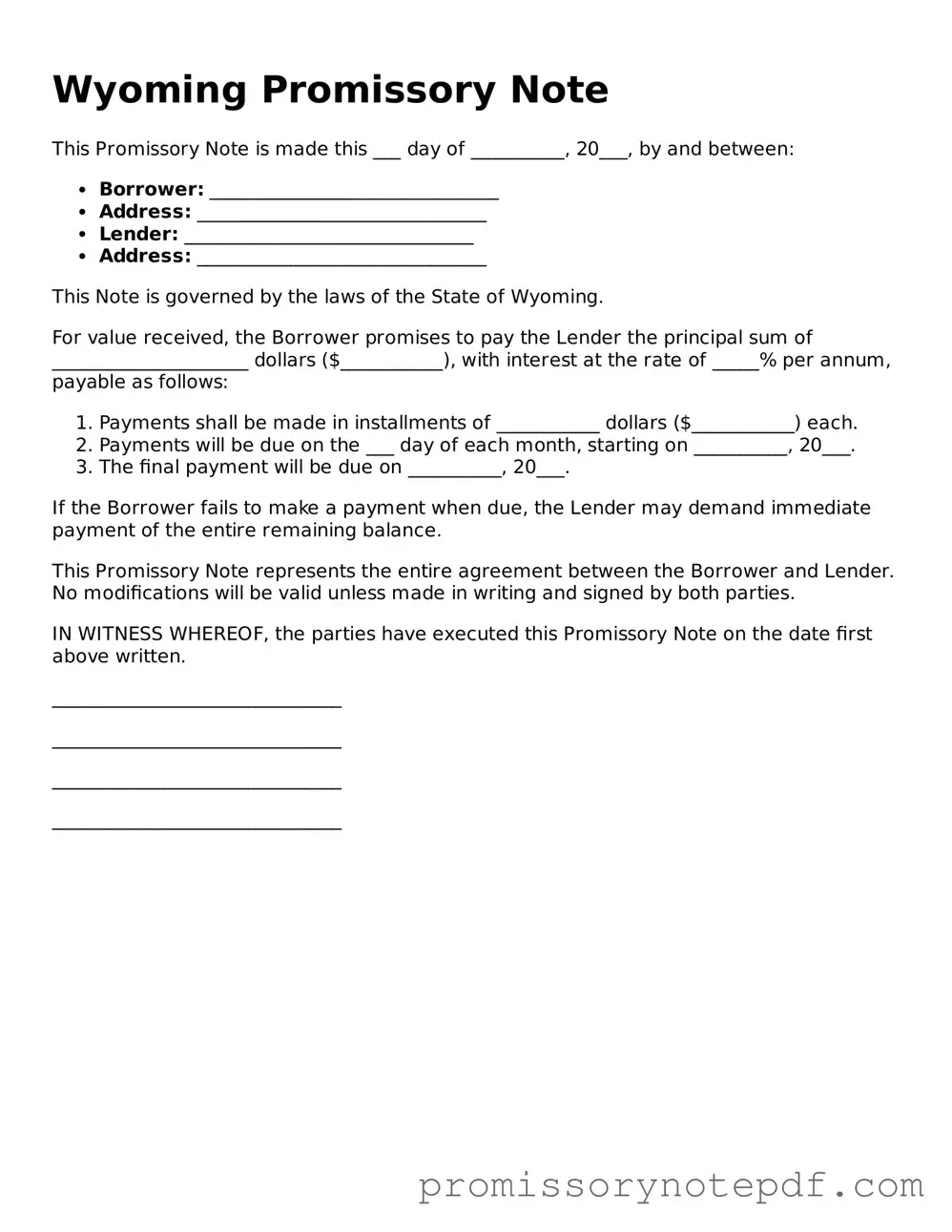The Wyoming Promissory Note form shares similarities with the Secured Promissory Note. Both documents outline a borrower's promise to repay a loan, but the secured version includes collateral to protect the lender. This means if the borrower defaults, the lender has the right to claim the specified asset. The inclusion of collateral adds a layer of security for the lender, making it a common choice for larger loans or riskier borrowers.
Another document akin to the Wyoming Promissory Note is the Demand Note. Like a standard promissory note, it represents a borrower's promise to pay back a loan. However, the key difference lies in the repayment terms. A demand note allows the lender to request repayment at any time, providing greater flexibility. This can be advantageous for lenders who want to maintain control over their investment.
The Installment Note is also similar to the Wyoming Promissory Note. Both require the borrower to repay the loan amount, but the installment note specifies a series of scheduled payments over time. This structure can ease the financial burden on the borrower, allowing them to manage their cash flow more effectively. The predictability of payments can also benefit lenders by ensuring consistent cash flow.
The Unsecured Promissory Note differs from the secured version but is still closely related. In an unsecured promissory note, no collateral backs the loan. This means the lender takes on more risk, as they cannot claim any specific asset if the borrower defaults. However, this type of note can be simpler and faster to execute, making it appealing for personal loans or smaller transactions.
A Commercial Promissory Note is another document that shares features with the Wyoming Promissory Note. This type is specifically designed for business transactions, detailing the terms under which a business borrows money. While the fundamental promise to repay remains the same, commercial notes often include additional clauses regarding business operations, making them more complex than personal promissory notes.
The Convertible Note is similar in its promise to repay but adds a unique twist. This document allows the lender to convert the debt into equity in the borrowing entity, usually at a later date. This feature can be particularly attractive to investors looking for potential growth opportunities. The conversion terms are typically outlined in the note, providing clarity for both parties.
A Loan Agreement is another document that parallels the Wyoming Promissory Note. While a promissory note focuses primarily on the borrower's promise to repay, a loan agreement encompasses broader terms, including interest rates, payment schedules, and conditions for default. This comprehensive nature makes loan agreements suitable for more complex borrowing situations, particularly in business contexts.
The Note Payable is closely related to the promissory note, as both represent a liability for the borrower. However, a note payable is often used in accounting to track the amounts owed by a business. This document outlines the terms of the loan but is typically more formalized for financial reporting purposes. It serves as a record of the debt on the balance sheet.
The Student Loan Agreement shares similarities with the Wyoming Promissory Note, particularly in its structure and purpose. Both documents outline the borrower's obligation to repay a specified amount. However, student loans often come with unique terms, such as deferment options and income-based repayment plans. These features cater to the financial realities of students, making education more accessible.
Finally, the Mortgage Note is another document that reflects a borrower's promise to repay a loan. This note is specifically tied to real estate transactions and includes terms related to the property being financed. While both documents serve a similar function, the mortgage note typically involves larger sums and includes provisions for foreclosure if the borrower defaults. This added complexity is essential for protecting the lender's investment in real estate.
